 | |
|  |
|
|
view titles only (low bandwidth) |
| |
| Wet Moon rocks and other space hazards | May 31, 2011 12:06 AM PDT | url |
| | |
Added 1 new A* page:I went to NASA's site to find a gratuitous Moon photo for reasons that will soon become apparent, but this popped up looking neat, and anyway it's topical, as it shows the Space Shuttle Endeavour docked at the International Space Station on the 28th.
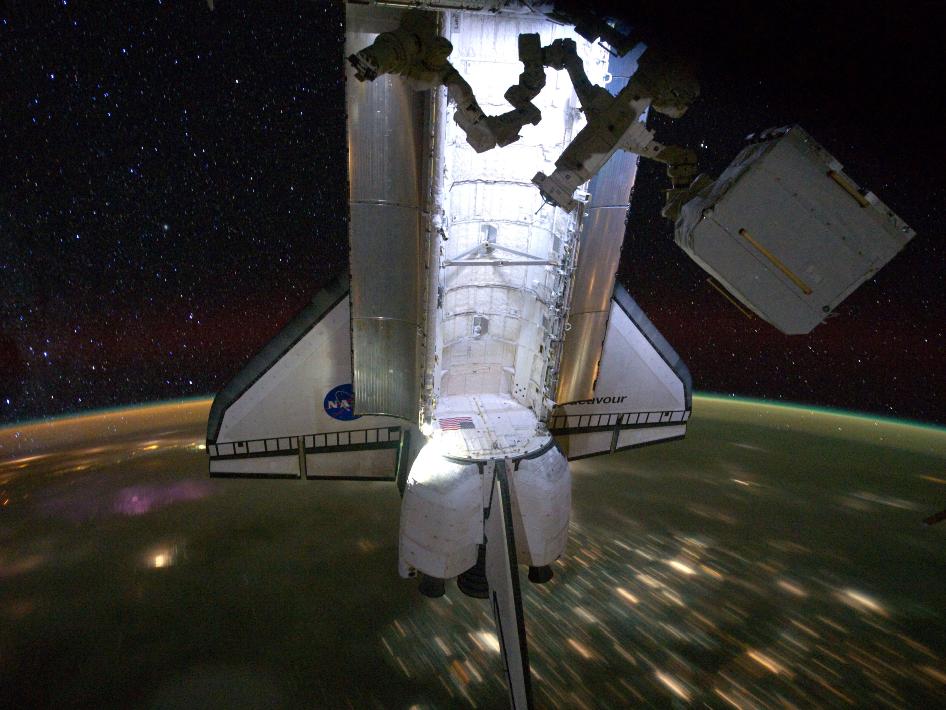
image by NASA (source)
Endeavour has left the station and is due to land on Wednesday; this is Endeavour's last mission, and the second-to-last Space Shuttle mission.
~~~~~~
Speaking of Endeavour though, this AP article from a week ago Sunday illustrates the difficulties and hazards of doing even simple things in space like refilling a coolant tank and lubricating a mechanical joint: Endeavour astronauts executing those tasks had to dodge frozen flakes of ammonia coolant, and then, during the joint work, catch a bolt that unexpectedly popped off.
Another bolt popped off and couldn't be caught, so it floated away into space, and is now presumably in Earth orbit, joining tens of millions of other pieces of dangerous space debris up there; with the high relative velocities of space travel, that bolt could some day--although it is incredibly unlikely that this particular bolt would be involved out of all the debris up there--end up causing critical damage to a passing spacecraft.
~~~~~
Speaking of junk from space, this AP article from the day before the other one tells of a NASA sting operation ending in the successful detention of a California woman trying to sell what she claimed was a rock from the Moon, for which she was asking $1.7 million--unfortunately for her, her prospective buyer turned out to be an undercover NASA agent (I didn't know they had those!).
According to the article, the Apollo missions brought back 840 pounds--2,200 rocks--of Moon stone between 1969 and 1972, and pieces were given by President Nixon to all 50 states, and to 136 countries; the rocks "are considered national treasures and are illegal to sell." Many of them have gone missing in the intervening decades, however, and "a recent count showed 10 states and more than 90 countries could not account for their shares of the gray rocks," and the black market for real (or fake) Moon rocks has really taken off. For instance, in 1998 a NASA sting recovered one of Honduras' Moon rocks that was going for $5 million on the black market, and in 2009, a museum in the Netherlands found that one of its rocks was a fake.
Hm, NASA still has a lot of the rocks...and could always use more money... Ah well I guess they want to keep them for research and historical purposes and all that. The article also mentions that one way you can tell if a lunar rock is legit is if it is found to contain armalcolite. Armalcolite is a titanium-rich mineral discovered in lunar rocks, and named after the three Apollo 11 astronauts (ARMstrong, ALdrin, and COLlins); it has since been found on Earth, and synthesized in labs. And two other minerals were discovered in Moon rocks: tranquillityite, since found only in a Martian meteorite that landed in Africa, and pyroxferroite, later found in lunar and Martian meteorites, and in the Earth's crust.
As of the article's publication, it doesn't seem that they knew whether or not the captured "Moon rock" was legitimate.
~~~~~
And finally, this AFP article (hadn't looked them up before; apparently it's French news agency Agence France-Presse--founded in 1835!--but I can't get their web site to respond :P) cites a new study saying that the interior of the Moon may contain 100 times more water than previously supposed. They studied some of the "orange glass soil" brought back by the final Apollo mission, 17, in 1972
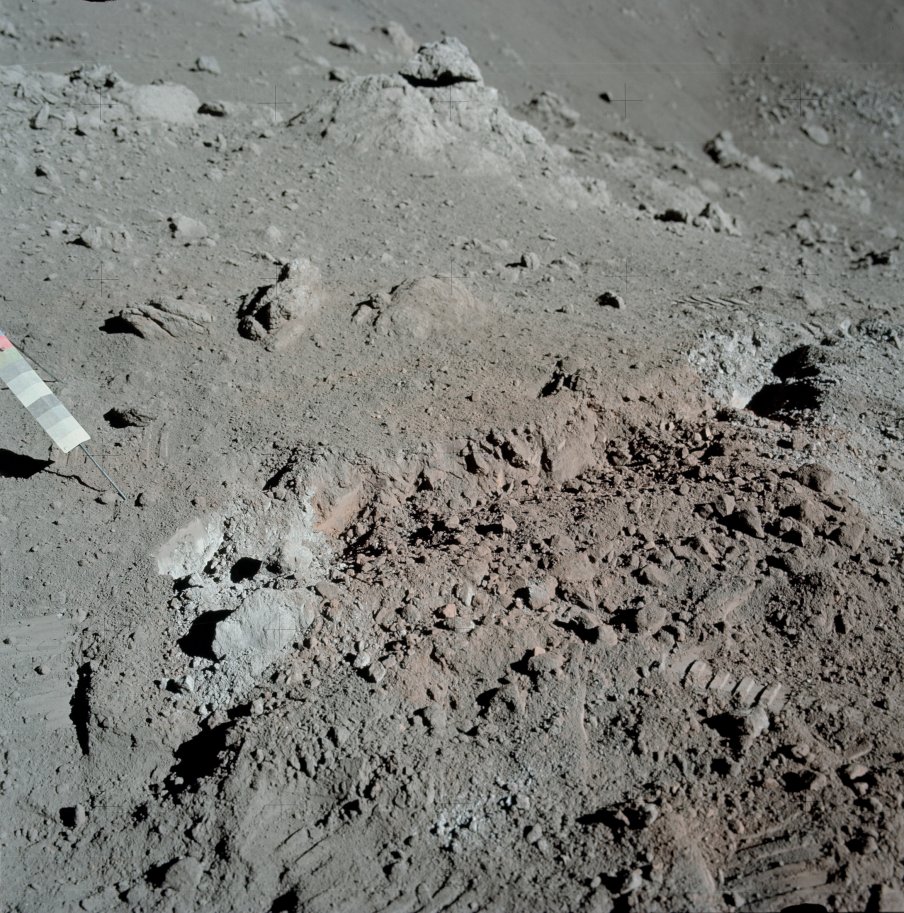
image by NASA (source)
(the orange color "is caused by microscopic glass beads created by volcanic processes earlier in the Moon's history" (3.7 million years ago, according to the AFP article)), specifically examining tiny rock samples inside it that were hermetically sealed in the crystal, and had thus retained their moisture. Their finding: that old lunar magma had about as much water in it as lava found here on Earth--so maybe the Moon isn't, or at least hasn't always been, as dry and dusty as its modern exterior would suggest!
One thing I particularly like about this finding is that while it suggests the Earth and the Moon may have had a common origin, it pretty nearly nixes the silly yet popular theory that the Moon is a chunk of the Earth that got dislodged by an impact with another planet that has since mysteriously vanished; in fact, the Wikipedia article on that so-called giant impact hypothesis still says it's "the favored scientific hypothesis for the formation of the Moon," even though that's based on such circumstantial evidence as once-molten material on the Moon, and the Moon's supposedly tiny iron core. Well, hopefully this wet Moon finding will put the damper on that silly theory eventually (I mean really, like you hit a planet with another planet and a nice moon just pops out, one planet survives just fine, and the other vanishes altogether, riiiiight :P), since an impact like that theory proposes would have been so energetic as to vaporize any moisture that could have been in the eventual Moon--and yet there is in fact moisture in these old Moon rocks.
|
·····
|
| |
| Dark in light | May 28, 2011 5:11 AM PDT | url |
| | |
Added 1 new A* page:I kinda like how the drawing of Selenis came out on this latest page; I've tended to shy away from my old silhouette drawing method (that is, draw the character's silhouette against the background, then carve details into it) in brightly lit areas like this Andiran Robotics space station office interior, especially when the character is light colored, because I didn't think the heavy dark areas of the silhouette method would look right in such lighting conditions, but it seemed to work pretty well here, so maybe I need to rethink that.
Well anyway it's Friday (or at least I'm pretending it's still Friday...), so I don't have to think about that again until Monday, and early next week this rather longish but important character establishing scene will wrap up, and we'll start getting into more of the station, which will carry us close to Selenis' unsuspecting prey.
Before that of course I'll be doing a new page of my Sunday fairy tale comic, The Princess and the Giant, and if you didn't catch last weekend's page yet--which really brought down the house, if I may say so--here's a handy preview/link banner you can use to get to it, so you'll be all set for the next page this weekend:

|
·····
|
| |
| This just in: a galaxy springs to life? | May 27, 2011 3:59 AM PDT | url |
| | |
Added 1 new A* page:Continuing on from yesterday with the theme of gamma ray bursts, the Swift satellite that detects them, and supermassive black holes, something unprecedented has been observed in the heavens since March 28th of this year! That's when Swift detected a large gamma ray burst--but it didn't stop! Even a burst from a supernova will cut out after a few seconds, but it's been nearly two months now, and from the looks of the Wikipedia article on this burst, GBR 110328A (also known as Swift J164449.3+573451, or Sw J1644+57 for short), it's still going. Here's an image Swift took of it on March 28th, in which the red/yellow X-ray reading is combined with white and purple optical data of nearby objects:
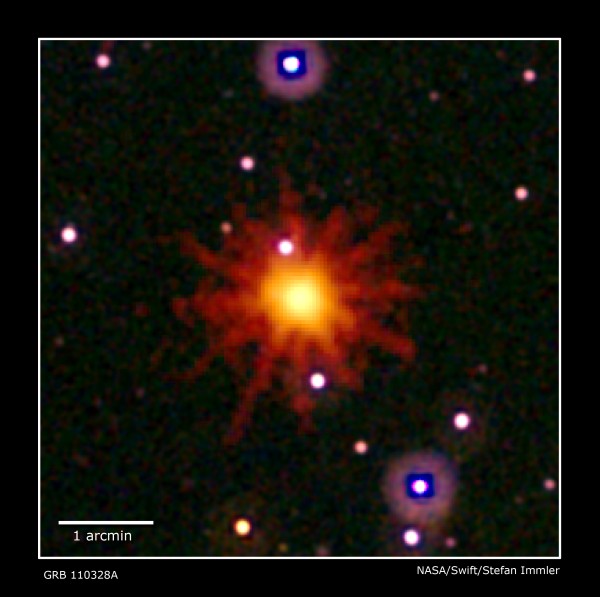
image by NASA (source)
Most gamma ray burst images I've seen from Swift are just blurry red dots; this nice big flared one is unusually powerful, especially considering how long it's been going on. Not only that, but there have been a lot of flares in the signal, suggesting that a dynamic situation took place at the source.
Well, this was big stuff, so big that both Hubble and Chandra--which also reads X-rays, but with more positional precision than Swift--were called into action to take a look, and, according to this NASA article, Hubble spotted a small (apparently unnamed) galaxy at that location, 3.8 billion light years away, and Chandra was able to determine that the burst was coming from the approximate center of that galaxy.
Which means it's probably a jet of material shooting out of a magnetic pole of a supermassive black hole, aimed directly at us. This isn't unusual--that's what most quasars, or more specifically blazars, are thought to be--but this will have been the first time that one has been observed starting up: that is, the first time the supermassive black hole center of a galaxy has been observed going from a dormant to an active phase as a large amount of matter drifts into it and starts getting swallowed up.
That NASA article says the supermassive black hole is probably smaller than A*, the one at the center of our own galaxy (A* is about 4 million solar masses), but this slightly earlier scientific research paper on it estimated the hole to be about five times the mass of ours, or 20 million solar masses; maybe the NASA article shows that number has since been revised.
The article makes the case in detail for the burst being a jet from a newly activated supermassive black hole, showing that the energy curves since the supposed start-up time have differed from the standard curves of blazars or tidal disruption of stars by supermassive black holes. Such events have been inferred from indirect data before, but not observed directly--and those were fairly short events, and didn't have the flaring activity that this one has had. So this really could be the first observed birth of an active galactic nucleus (AGN), and it could end up teaching us a lot about how supermassive black holes and the galactic cores around them change--how galaxies evolve, in fact. Exciting!
|
·····
|
| |
| Swift black hole videos | May 26, 2011 4:11 AM PDT | url |
| | |
Added 1 new A* page:BBC News just reported that NASA's Swift satellite, which studies gamma ray bursts, caught a burst in April 2009, "Gamma Ray Burst (GRB) 090429B," that they now believe is the most distant object yet known: the detected burst of gamma rays, which are a highly energetic form of light, registered as a fuzzy little red dot just at the edge of their detection capability, and is thought to have come from a massive explosion, perhaps a supernova, occurring 13.14 billion years ago, or just 520 million years after the hypothetical Big Bang.
It's interesting to think of all the mysterious bursts of light zinging all around us; this one over 13 billion years ago flew out of a supernova or something, heading just precisely in the direction the not-yet-formed Earth and Sun would occupy much later. And I tried looking this up, but failed; I never see it mentioned, so it's probably wrong for some very obvious reason, but are all those photons, ancient and new, winging around in space, considered when thinking of what "dark energy" might be? Or are they already included in the calculations for regular energy? I guess since scientists seem to think they know roughly how many stars the universe has had and does have, they can calculate the approximate energy output these would have given off, or whatever... And what about the very slight physical pressure--since photons supposedly have just a tiny tiny smidge of mass to them--from all these photons going everywhere? Could that be part of the force causing the expansion of the galaxy? Somebody who knows this, please let me know. :P
Anyway that article got me poking around NASA's Swift mission site ("Swift" refers to the bird, and is not an acronym, according to Wikipedia), and man if they don't have a bunch of recent videos concerning black holes! Which makes sense since gamma rays can only come from really energetic stuff like what happens around the massive gravitational pull of black holes.
In this video they show the results of a Max Planck Institute supercomputer simulation of merging neutron stars: neutron stars come from supernovas of stars not quite big enough to collapse into black holes, but if two neutron stars then come together, which is the crazy thing this simulation tested, that swirling meeting would produce a huge magnetic field that turns out to quickly coalesce into the torus shape necessary to form intense jets of matter shooting out of the poles of the new central black hole: and those jets are where the energy we detect as *short* gamma ray bursts comes from: most GRBs last a few seconds, and those are thought to come from supernova explosions, but there are much shorter ones, too, and until now it wasn't clear where those short ones could come from; ie, what could create an energy burst of such intensity, but only for a very very short period. Apparently merging neutron stars could do it. Mystery solved?
In the next video it's reported that Swift has been able to detect the "missing" active galaxies in the visible universe around us--that is, the galaxies where the central supermassive black hole is sucking in huge clouds of matter, and emitting energy as a result in the form of X-rays. But a lot of these have gas and dust around them--or are sideways to us, so we're seeing them through their surrounding disc--so the X-rays get aborbed, and we can't detect them--until now. Swift is sensitive enough to spot them, and in fact has been finding so many of these heretofore unseen active galactic centers that they say the energy they emit (hey this gets back to that question I had about emitted energy zinging around the universe, in a way) could account for nearly all of the universal background radiation. The findings also seem to confirm that galactic activity in our universe reached its peak about 7 billion years ago, when loads of galaxies had had time to form, and were now crashing into each other and so forth.
Which brings us to the third video, which is a nifty simulation of two galaxies colliding; this simulation shows that the disruptions to their shape as they close together would feed material into their central supermassive black holes, making them activate, and then, once the supermassive black holes merged, the resulting "wind" from that merger would blow away most of the remaining galactic material. Anyway, it's pretty.
~~~~~
I have three more videos, and these have nothing to do with astrophysics really. I just heard this song "Eight Zero One" by Lacunae today, and went and looked it up on YouTube, and what do you know but the group has just recently put up a pretty neat video for it.
video on Youtube
That high-contrast look is sort of like Photoshop's "threshold" filter, which I used to play around with a lot to break photos or game screenshots down to stark black and white images, and doing that kind of got me interested in going back to Photoshop's "Lasso Tool" to try to draw such images by hand, which eventually resulted in the sharp black and white look of A*. So it's a look I like.
Lacunae also have a bunch of other really nice songs with inventive videos on their YouTube channel; a few others I quite like are The Loneliness of Lovers and the appropriately-named-for-us Stars Burn Out. Lacunae are sort of a post trip hop group, and I'm a big trip hop fan; there are very few remaining trip hop groups these days, so it was nice to find Lacunae's particular brand of hyper-cut beats.
~~~~~~~~
I should also mention that I'm probably going to be putting ads on the site in the near future, maybe starting in a week or two; if it goes according to plan, they'll roll out in a couple phases. This time I intend to have them all below the comic, in a sort of row of squarish things, basically aping the ad layout of Buttersafe.
|
·····
|
| |
| The Book of Dynamic Stars | May 25, 2011 3:07 AM PDT | url |
| | |
Added 1 new A* page:This Time.com article just so happens to share a name with today's A* page ;) (it also involves a scientist from my alma mater, woooo), which is just coincidence though and I'm mentioning it because it's talking about a new-ish theory that planets previously thought to be uninhabitable due to being too cold--too far away from their star--*could* possibly be warmer than previously thought, since if they had sufficient mass/gravity they could have an insulating atmosphere say of hydrogen, which doesn't condense when it gets cold like typical greenhouse gasses water vapor and carbon dioxide do. Also, it's pointed out that light from reddish stars, although less powerful, could warm planets with such atmospheres more than had previously been calculated because red light, being less energetic, scatters less than other light when it hits a gas, and thus is more efficient in warming an atmosphere (this is also why sunsets are red!).
And then I just wanted to post some pretty Hubble pictures I found on Wikipedia's open cluster page; an open cluster is a loose conglomeration of usually up to a few thousand stars that all formed from the same molecular cloud. They tend to stick together only for up to a few hundred million years before stronger forces pull them apart, but they're handy for studying stellar evolution because you know almost all the stars in an open cluster are about the same age and distance, so its easier to compare their other properties.
As for open clusters in our own galaxy--which may of course be of concern to A*--Wikipedia says:
"There are over 1,000 known open clusters in our galaxy, but the true total may be up to ten times higher than that. In spiral galaxies, open clusters are largely found in the spiral arms where gas densities are highest and so most star formation occurs, and clusters usually disperse before they have had time to travel beyond their spiral arm. Open clusters are strongly concentrated close to the galactic plane, with a scale height in our galaxy of about 180 light years, compared to a galactic radius of approximately 100,000 light years."
Well that's great but they also make for some nice pictures! So here we are:
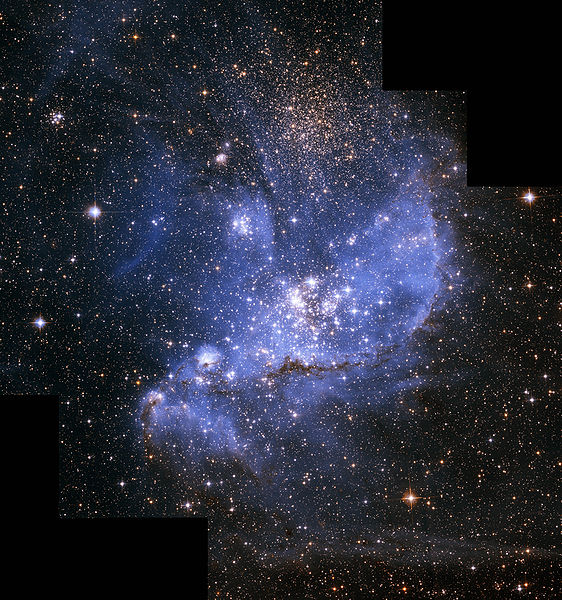
image by NASA (source)
^ That's NGC 346, an open cluster in the Small Magellanic Cloud, a dwarf galaxy only 200,000 light years from the Milky Way, about 7,000 light years across (the Milky Way is itself about 100,000 light years across), and containing several hundred million stars.
As you might guess from the name, there's also a Large Magellanic Cloud, a slightly less dwarfy galaxy that's somewhat closer (160,000 light years) and bigger (14,000 light years across, 10 billion solar masses) than the Small Magellanic Cloud.
As you also might guess from their names, since they're visible with the naked eye in Earth's southern hemisphere, they were observed by Antonio Pigafetta, a Venetian scholar who went along on Magellan's trip to the Indies (1519-1522; of 240 who set out, only he and 17 others made it back!); the journal he kept of the voyage is one of our main sources of information on Magellan's travels. Pigafetta described them as "dim clusters of stars," according to Wikipedia.
That was the first European observation of the Clouds, but they had been observed way before that; they featured in the lore of south seas islanders, and if you want a date, the Persian astronomer Abd al-Rahman al-Sufi, who lived from 903 to 986, recorded observations of the Large Magellanic Cloud and even the big Andromeda Galaxy in the Book of Fixed Stars he produced in 964--it was the first recorded observation of those galaxies.
So the southern hemisphere has it pretty good in terms of star watching--you can also see the band of the Milky Way from down there. In fact, here's a panorama of both Clouds (on the left) and the Milky Way (that big brown hazy stripe along the horizon), as seen from the European Southern Observatory (ESO) in Chile (that's one part of the observatory's Very Large Telescope (VLT) on the right):
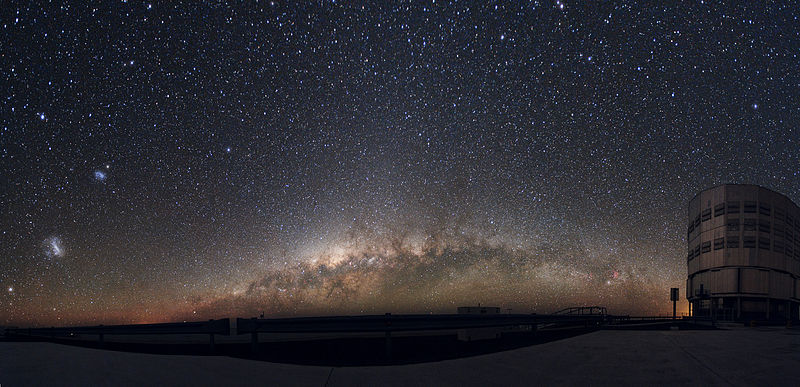
image by European Southern Observatory (source)
Wouldn't that be something to see if you just happened to go outside one fine night in the high Chilean desert?
Okay the other open cluster picture:
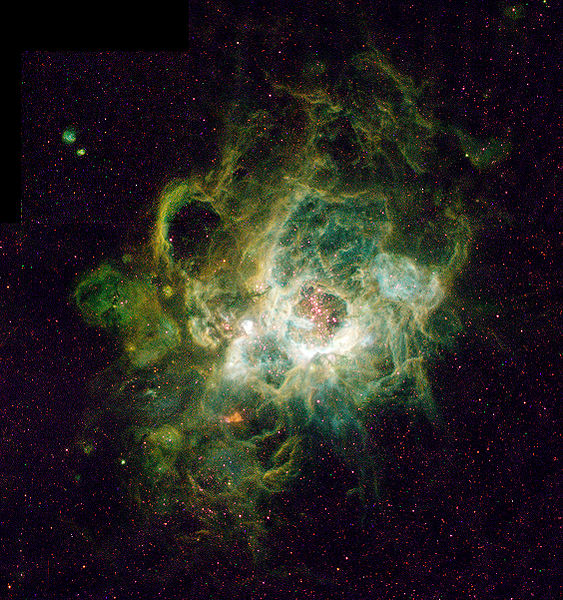
image by NASA (source)
^ That's NGC 604 in the Triangulum Galaxy (also known from its listing number in early star catalogues: Messier (Messier objects listed by Messier in 1771) 33 or NGC (the New General Catalogue from the 1880s) 598), about 3 million light years from Earth, which is still relatively close in galactic terms; in fact, it's part of our gravitationally bound Local Group (so is Andromeda, aka Messier 31 or NGC 224!). Cluster NGC 604 itself is about 2.7 million light years away, and 1500 light years across. It's one of the largest H II regions in the Local Group; an H II region is a big cloud of gas and ionized gas in which star formation goes on--the "H II" part comes from the symbol for ionized atomic hydrogen, which they contain in great abundance. H II regions are important for study because they're where to look if you want to see stars in the process of forming, or if you want to see radical young stars doing crazy stuff: a few hundred huge stars (each 15-60 times as big as our own Sun) at the center of NGC 604 are ionizing and blowing up all that gas, forming that spectacular 3D structure you see in the image.
H II regions also include many more of the coolest-looking nebulae, so if you want to check out some more spectacular pictures, click that last link and scroll down a bit. :)
|
·····
|
| |
| Slow drawing and quick painting | May 24, 2011 4:49 AM PDT | url |
| | |
Added 1 new A* page:Oh man, new record for slow drawing on this page, I think! Whew.
Over the weekend on the other hand I painted a quick sloppy and colorful version of Selenis, just playing around with a free painting program called Artrage Starter Edition. Click on this cropped detail to see the full thing in the gallery (it's big!):

Man, that program takes me back to the ol' college days, sloshing around oil paint and thinner in a rickety little garret on the third floor of Lorado Taft's (now) 100-year-old studio building on the south side of Chicago, in winter. Those were the days! Of sorts.
Anyway although you can't adjust the simulated paint thinner and stuff like that in this free 10 MB version of Artrage, it's a really good simulation of oil painting, and just darn fun to play with. Give it a shot!
|
·····
|
| |
| "Fun Times with Proctor & Mar" spinoff series | May 21, 2011 7:33 AM PDT | url |
| | |
Added 1 new A* page:Well I had so much fun with that little doodle yesterday that I decided to make "Fun Times with Proctor & Mar" a series, albeit one that updates haphazardly, ie when I feel like procrastinating from drawing real A* storyboards because I'm at a particularly delicate part in this episode's plot--or some situation like that, that was just a um random example yeah. So if you just can't get enough of the zany space adventures of the Core Sys twosome, set your bookmarks to funtimes.smbhax.com--or just stick around here, because I think I'll just be copying them into the A* news as I do them (they also make for a good excuse when I don't want to write a real news article! :D), like so:
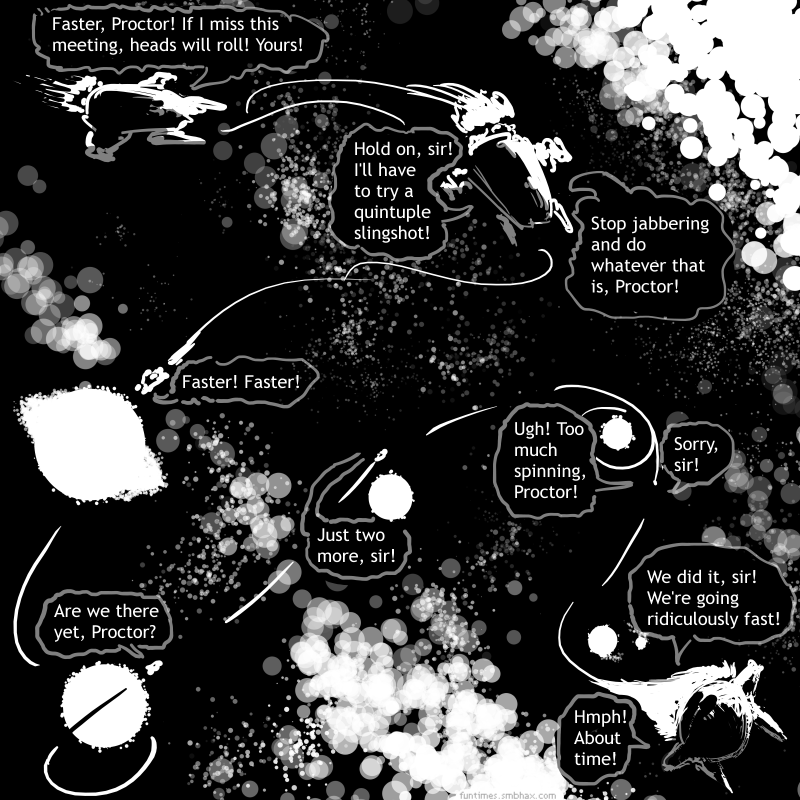
I'll also post links to them on A*'s Facebook page and A*'s Twitter feed, so you can get notified of them that way too. I probably won't be doing them on anything near like a daily basis or anything, but I guess we'll see just how much procrastination I end up needing. :P
Oh yeah and let's not forget that my rather more regular Sunday fairy tale series, "The Princess and the Giant," will be having a new page out this weekend; if you managed to avoid checking the one from this past weekend, why you can get to it by clicking this suspenseful cropped banner version:

So yes I sort of have six webcomic series now. >_> (Does this surprise you? Then you may not have seen the more comics by me page, which keeps them all in a nice tidy last-updated list.)
|
·····
|
| |
| R U ready 2 laff? 2 bad | May 20, 2011 6:19 AM PDT | url |
| | |
Added 1 new A* page:Blug! Spent too long drawing this, I got nothin' easy to post along with it newswise and I should probably just go to bed. :P I was even thinkin' earlier that I'd do a quick comedic Fun Times with Proctor & Mar doodle, but now I don't even have time for that.
Aw heck with it, we're doin' it.
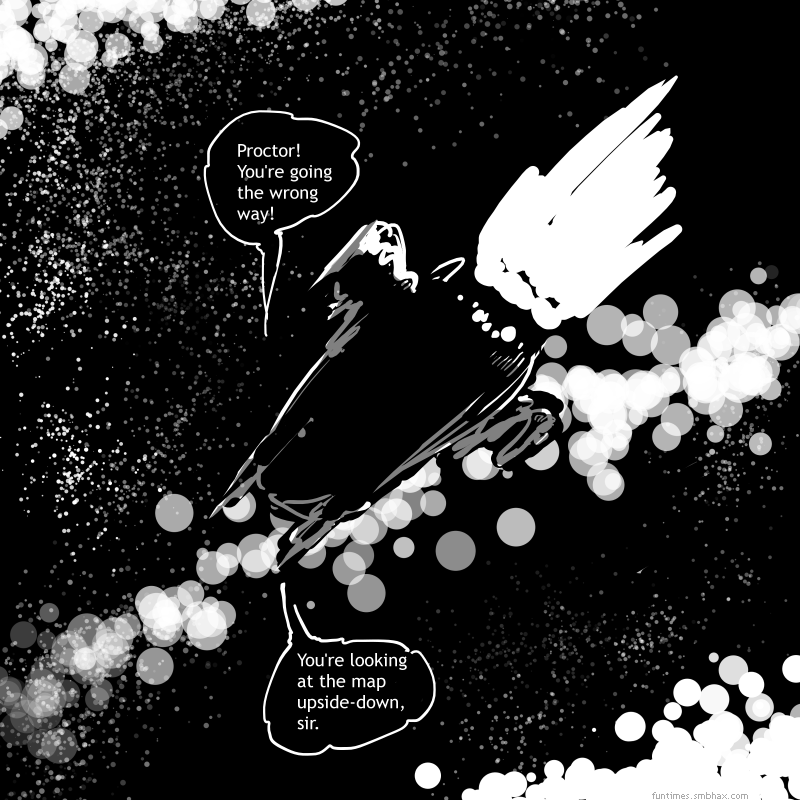
There we go! Hahaaaaa. Man we will never stop laughing now; we need a black hole to swallow all these laughs. And that drawing.
|
·····
|
| |
| Yippy I-o and Bad Machinery | May 19, 2011 3:04 AM PDT | url |
| | |
Added 1 new A* page:I've been naughty and getting A* pages up a little later in the evening...okay more like in the wee hours of the next morning...than I should in the past few days because I've been binging on the archives of the webcomic Bad Machinery and the not-drawn-in-Illustrator chapters of its predecessor, Scary Go Round. They're about plucky British schoolgirls who solve zany mysteries and say things like "cor"; together with author John Allison's off-kilter dialogue, often bizarre plots, and quirkily elegant artwork, I don't know if anything could possibly be more charming.
I'd hesitated to get into it because his comics have been around forever and are frequently cited by the popular webcomic crowd, but looking at his viewer numbers it appears that his comics are rather under-read considering how lovely they are, so supporting them is entirely acceptable to that otherwise jealous, success-hating section of my lizard brain. I've duly added Bad Machinery to my webcomic reading list.
~~~~~~~~~~
Came across an interesting AP article saying that, by looking for gravitational lensing of background stars, astronomers observing a slice of the Milky Way have found ten possibly Jupiter-sized planets that are either in very, very wide orbits around distant stars, or not in stellar orbits at all. And if you think about it, that shouldn't be too unexpected, since it's thought that even in the formation of our own solar system there were planets crashing around all over the place. It's kind of neat to think that space could be filled with just as many rogue planets as stars. The article doesn't mention it, so maybe there's a reason why this wouldn't be the case, but it occurred to me also that some of these could simply be very, very small would-be stars that failed to accumulate the requisite mass for stellar fusion--sort of sub brown dwarfs.
~~~~~~~~~~
This recent NASA article says that data from the Galileo spacecraft (sent to Jupiter in 1989, intentionally crashed into the planet in 2003) shows that Jupiter's moon Io--the only other active volcanic body in the solar system aside from Earth--(here's an "enhanced color" photo of Io by Galileo)
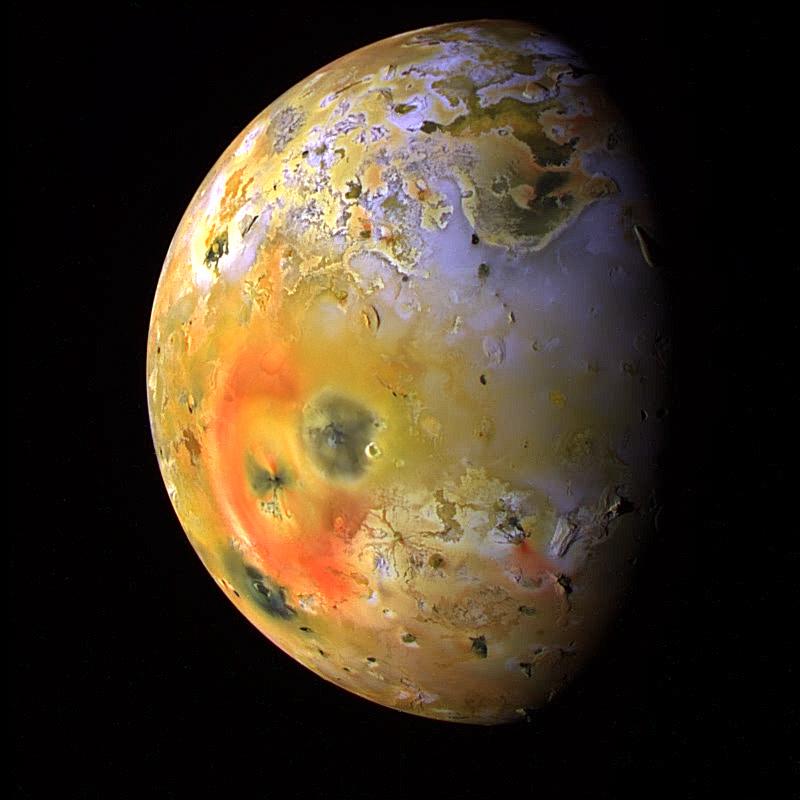
image by NASA (source)
has a 50-kilometer-thick ocean of magma 30-50 km beneath its surface; other bodies in our solar system, such as Earth, are thought to have had magma oceans after their formation, but these have long since cooled; Io's is kept warm by the pull of Jupiter's massive gravity, which squeezes and stretches the moon by as much as 100 km.
Galileo had picked up unusual signatures in magnetic field data in two flybys of Io, and modern analysis has shown that this was probably caused by the presence of the massive magma ocean described above: it's been found that a certain type of rocks that form from cooling magma ("ultramafic" rocks) "become capable of carrying substantial electrical current when melted," and the presence of these in huge quantities--ie in said massive magma ocean--would explain the magnetic field anomalies caused by Io.
~~~~~~~~~
And I'm not even going to embed this because its too silly, but at certain points like this one in Little Boots' "Earthquake" music video, there's a visual effect that I think is meant to be like a supernova explosion--obviously a slightly cheap effect, but still somewhat effect-ive, I think. Well anyway it's pretty. :P
|
·····
|
| |
| What's in a Mer? | May 18, 2011 5:01 AM PDT | url |
| | |
Added 1 new A* page:Congrats to @elephande and a little detective work for figuring out where I got Selenis' cover name for this episode, "Mer Sidereus" (this was going on over at A*'s Twitter feed thingy, by the way!). "Sidereus" came from the name of Galileo's treatise containing his early observations of heavenly bodies through his telescope: the Sidereus Nuncius was the first scientific treatise based on telescopic observations, in fact! I think I got to it from just eh poking around through star names on Wikipedia.
And I got "Mer" from "mare," which is of course Latin for "sea," and the first part of the names of craters on the Moon--in keeping with Selenis' lunar name scheme. "Mer" is also the exact French word for "sea," but I don't think I noticed that until later. And if you're wondering, I think of it--in her name here in the episode, I mean--as rhyming with "her," rather than "hair," as it would be in the Latin or French; besides, that would sound exactly like the French word for "mother," which would be *totally* confusing, since that's what Selenis calls her primary computer program. Probably nobody in A*'s society speaks those languages anyway, except maybe some weird academics somewhere who might know bits. Why that might be is...something I won't tell you until later. :P
Anyway, "Mer" is already confusing enough, what with being one letter away from the last name of everyone's favorite paranoid Core Sys despot, Solvan Mar, who Selenis did something painful to a few episodes back. How clever is that? Only the best hack writers make that kind of name goof-up! ;) :P
"Sidereus" could translate to "sidereal" in English, which more or less means "starry," so I suppose her cover name could mean "Starry Sea" if you were being generous. Which would be quite the hippy (why doesn't Firefox's spell checker know that word? :P) name! But I mostly just liked the sound of it.
~~~~~~~~~
This AP article claimed thirteen seconds of the Space Shuttle Endeavour rising above the clouds, as filmed by a woman with her cell phone on a commuter flight, "went viral"; I dunno about that, but it *is* an unusual viewing angle of a Shuttle launch (and this is the second to last one, so I guess it's good someone caught it!):
video on Youtube
~~~~~~~~~
"The Game Archaeologist" and the friendly folks at Massively were kind enough to dig me up and ask me some questions about the gig I quit to do A*, namely being lead designer (by default! :D) on the now-defunct massively multiplayer game "The Matrix Online." They've put the resulting interview up on their site here.
|
·····
|
| |
| Blast off! | May 17, 2011 12:59 AM PDT | url |
| | |
Added 1 new A* page:
^ Drew that silly thing over the weekend; I guess I miss drawing Selenis' space suit or something. =p The drawing lives in the episode 13 gallery, here.
The Space Shuttle Endeavour, after a few weeks of delays, finally blasted off for the International Space Station this week; it will deliver the Alpha Magnetic Spectrometer, which will look for all kinds of weird things like antimatter galaxies and "dark matter" stuff. I put a bit more detail about it at the bottom of this post two weeks ago. Funny how these Reuters and I think AP news articles only ever refer to it as "an expensive physics experiment"--like they don't want to have to use big words like "spectrometer," or something. :P
|
·····
|
| |
| Holy suicidal comets! | May 14, 2011 12:47 AM PDT | url |
| | |
Added 1 new A* page:Hey, it's the weekend! On Sunday I'll draw and post a new page of my weekend fairy tale comic, "The Princess and the Giant." If you haven't been keeping up, here's a little teaser banner you can click on to go right to the page from last Sunday:

~~~~~
Okay enough princesses--some science just happened in space!
First, some background. The SOHO ("Solar and Heliospheric Observatory") satellite--owned by a European industrial consortium, so its photos aren't public domain, blah--launched in 1995 to a gravitationally balanced point between the Earth and the Sun; the Sun is so massive relative to the Earth that this point is actually just 1% of the way to the Sun from Earth! (Interestingly, all of SOHO's gyroscopes failed after an attitude control problem in 1998; fortunately, the mission engineers figured out a way to use its onboard reaction wheels (basically a wheel spinning by means of a motor--this causes the craft to rotate very slightly in the opposite direction due to conservation of angular momentum) to control its orientation, making it the first spacecraft of its type to control its attitude this way.)
And now let's go back even further--all the way to 1106, when the Great Comet of 1106 was seen by observers all over the globe--it was quite a comet, apparently. Well, since then, other big comets have been seen along what seems to be a similar trajectory; among recent spottings, these include the Great Comet of 1882
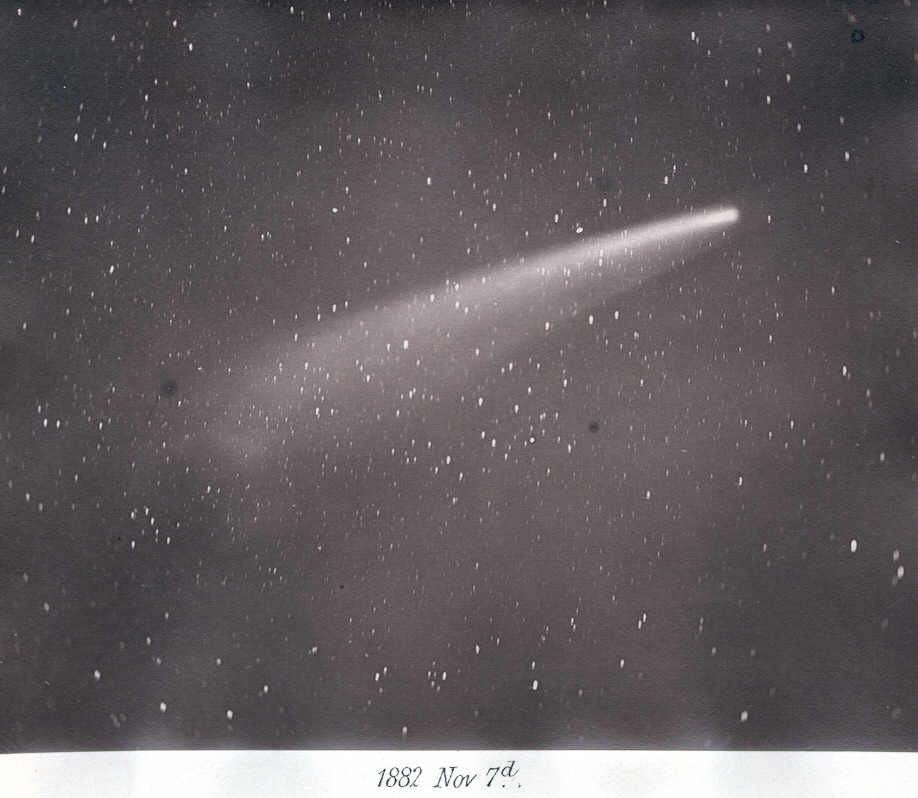
image by David Gill (source)
and Comet Ikeya-Seki, aka the "Great Comet of 1965"
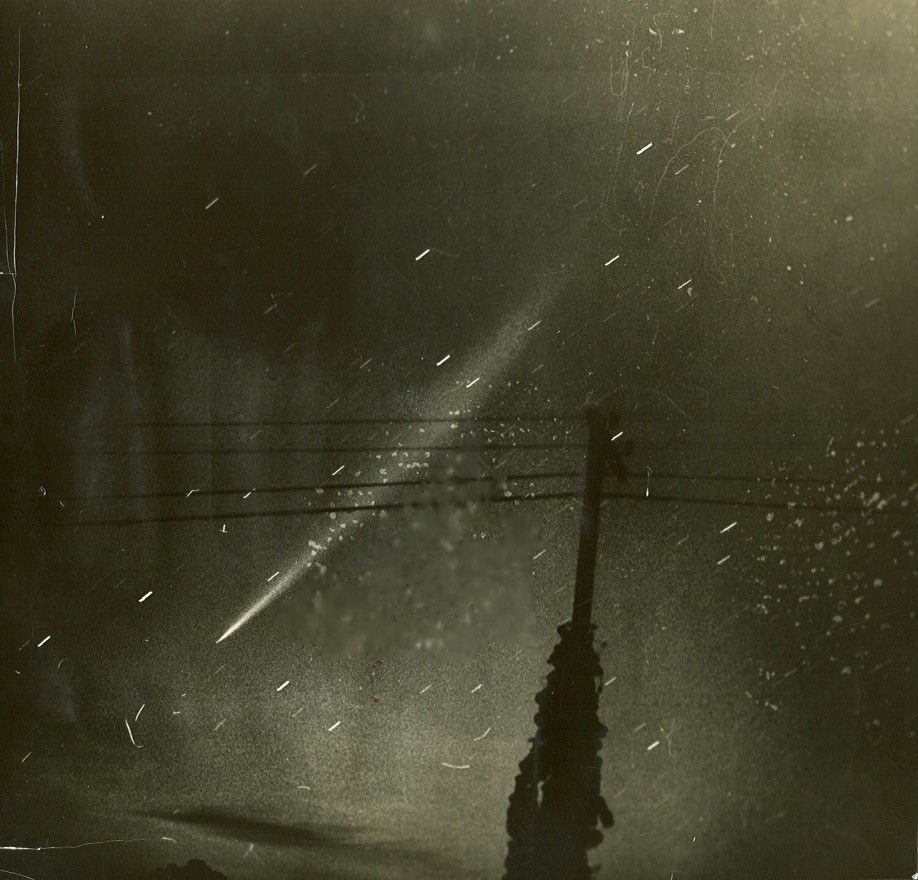
image by Maynard Pittendreigh (source)
which may have been the brightest comet seen since the great one of 1106. All of these comets pass very close to the sun, and calculations show that these later ones may all be pieces from a breakup of the 1106 comet; as a family they're called Kreutz Sungrazers after the dude who studied them and determined that they were related.
SOHO has proven to be very good at spotting these sun-grazing comets; as of 2008, 1500 had been identified, and "more than 75% of the SOHO sungrazers have been discovered by amateur astronomers analysing SOHO's observations via the Internet." Also, they often show up in pairs, which is thought to be the result of a larger one splitting up as it nears the Sun. None of them have survived--they either go into the Sun, or evaporate on their way toward it. Here's a nice SOHO photo of a pair plunging toward their fiery doom.
That brings us to Tuesday/Wednesday of this week, when SOHO spotted a Kreutz Sungrazer plunging into the Sun at about the same time that the Sun was shooting out a big coronal mass ejection ("CME"). According to the space.com article, the events weren't related, since the CME started before the comet entered the Sun's magnetic fields, but the conjunction made for a nifty video, which apparently can't be embedded (time to get your stuff together, space.com! :P).
For some reason I couldn't seem to find the video on NASA's site, but I did find an article from January describing a comet storm lasting from December 12th to the 22nd, in which 25 comets were spotted plunging into the Sun. Poor lemming-like things! Anyway there's an animated GIF of one of them there (along with another big CME--hm! :P), and more details about Ikeya-Seki and other Kreutz Sungrazer stuff.
|
·····
|
| |
| B'gosh! | May 13, 2011 5:42 AM PDT | url |
| | |
Added 1 new A* page:Oh gosh, it's late! Well, I put an enlarged detail from one of this episode's earlier pages into the episode 13 gallery, and here it is:

Also, bonus points to you if you can figure out where Selenis' cover name on this new page comes from!
|
·····
|
| |
| My stuff @ the Rosebud; war against blandness | May 11, 2011 10:43 PM PDT | url |
| | |
Added 1 new A* page:My dad took a nice photo of my framed prints currently on display at the Rosebud Restaurant & Bar on Seattle's Capitol Hill:

My news post from the start of April, which is when they first went up there, has some more info, but basically they'll be there through the end of June, so you've still got nearly two months to catch them, should you happen to be in the area.
Kind of a kitschy arrangement they've got them in--I like my electrifying bio on the fuse box. :D
~~~~~~~~
Today's A* page introduces yet another new character. We'll learn his name (and Selenis'??) soon enough, but here's a look at how um tortured my character design process was; I should probably work on nailing down character designs very specifically in the thumbnailing stage, or at least well before I start the final art, but no, I live on the edge and do it on the fly:

I liked the low, angry look of the first attempt, but trying to refine it turned it awfully bland (like yesterday's all-gray page, if you saw it before I edited it and put the black back in it :P), and really he was too small anyway, so after struggling around for a while, I just had to erase and start from scratch, which rather miraculously worked pretty well, by my standards!
|
·····
|
| |
| The Jetman can | May 11, 2011 12:49 AM PDT | url |
| | |
Added 1 new A* page:I was discussing some stuff about asteroid mining last week, and linked Wikipedia's Asteroid Mining page, but there was something on there I forgot to mention, namely that it points out that all the heavy metals that we mine from the Earth came from asteroids that hit the Earth after the surface cooled, because any heavy metals in the original stuff that formed the Earth sank to the center of the planet when it was all still molten. So all the iron and gold and stuff that we have came from asteroids that arrived later!
~~~~
Well I came across this today--a Swiss dude dropped from an airplane and "flew" "over" the Grand Canyon using a jet-powered wing pack / glider sort of thing:
video on Youtube
So not long now until we can all have personal jet packs, right?
|
·····
|
| |
| Of sulphur and ships and seal meat | May 10, 2011 2:36 AM PDT | url |
| | |
Added 1 new A* page:I made a new font poem thing for my odd wordy webcomic thing, "word," over the weekend; you can check it out by clicking this little tiny piece of it:

~~~~~~~
Was led to an interesting science article on msnbc over the weekend, too: 4.5 billion year old meteorite yields new mineral, promises the title, and the article goes on to describe how scientists found a mineral known as "krotite" in a meteorite in Africa; krotite is "a compound of calcium, aluminum and oxygen," and "needs temperatures of 2,732 degrees Fahrenheit (1,500 degrees Celsius) to form"--they figure the meteorite must be really old, then--dating back to the feisty period of planetary formation in our solar system, in fact--because that's when high temperatures like that were available, or something. The article title's a little misleading, though, because krotite isn't new; in fact, we make it artificially in high-temperature concrete; this is the first time it's been found in nature, however.
Perhaps to make up for that, the article links to this livescience.com article about the discovery of a really new mineral in another probably-4.5-billion-year-old meteorite--this one from Antarctica; only a tiny, tiny bit of the new substance, dubbed "wassonite," was found in the meteorite
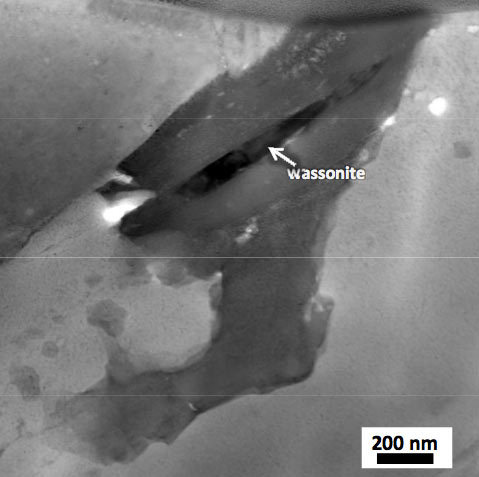
image by NASA (source)
but it was enough for the scientists to be sure that it "is a mineral formed from only two elements, sulfur and titanium, yet it possesses a unique crystal structure that has not been previously observed in nature."
The meteorite in which it was found, Yamato 691, was collected in "the blue ice fields" of the Queen Fabiola Mountains by the Japanese Antarctic Research Expedition way back in 1969; so they're still examining the expedition's findings over 50 years later, apparently; according to the livescience.com article, that was the "first significant recovery of Antarctic meteorites," and "follow-up searches by scientists from Japan and the United States have recovered more than 40,000 specimens, including rare Martian and lunar meteorites."
THAT linked to this space.com article about "Mars meteorite ALH84001," found by a snowmobiling scientist on an expedition in 1984
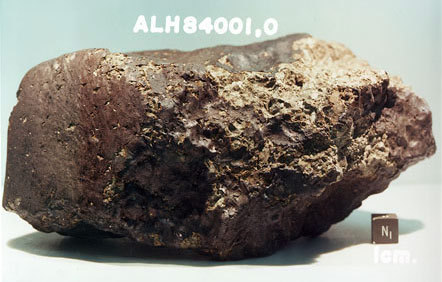
image by NASA (source)
It's thought to be about 1.3 billion years old, and to have got here from Mars when a large asteroid impact on the Martian surface would have knocked it into space--and onto an eventual collision course with Earth. Neat! Also, there was some big debate back in 1996 about various minerals on ALH84001 showing evidence for microbial Martian life, but it appears that that's died down somewhat as it's been shown for the most part that they could have formed by inanimate means.
(Skipping back a bit, I wanted to see what those "blue ice" mountains in Antarctica look like (the Japanese expedition ignored their existing English name and dubbed them the "Yamato Mountains"), because they sounded really cool, but strangely there doesn't seem to be a really good ground photo of them on the Internet. Best I could find was this satellite image from the US Geological Survey:
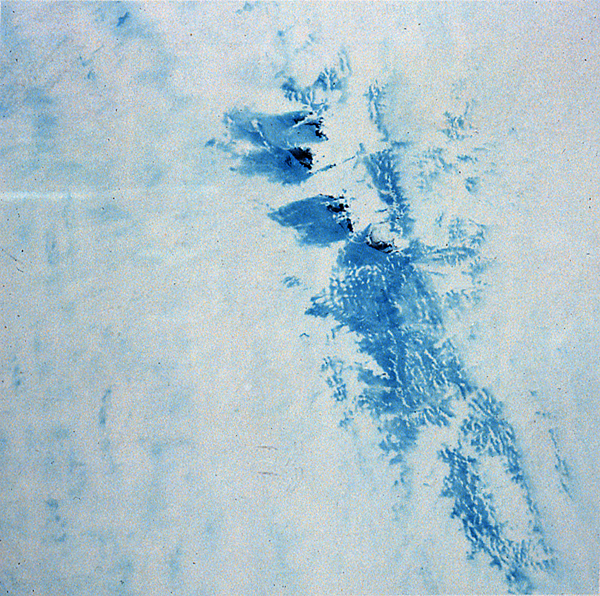
image by US Geological Survey (source)
Hah, I see from the USGS publication in which the photo first appeared that there's a "Mount Terror" in Antarctica (doesn't look like much, but there's a photo here); hang on, there's also a Mount Terror in my own state of Washington! Eeep!
The Queen Fabiola Mountains, incidentally, are named after the fabulous Queen Fabiola of Belgium, since they were discovered by the Belgian Antarctic Expedition in 1960, the same year in which she, a Spanish aristocrat, married King Baudouin of Belgium. She even has a bread in Spain named after her.
Amusingly enough, the Wikipedia Queen Fabiola Mountains article's Belgian Antarctic Expedition link actually links to a 1897-1899 Belgian expedition that sailed there aboard a ship named the Belgica
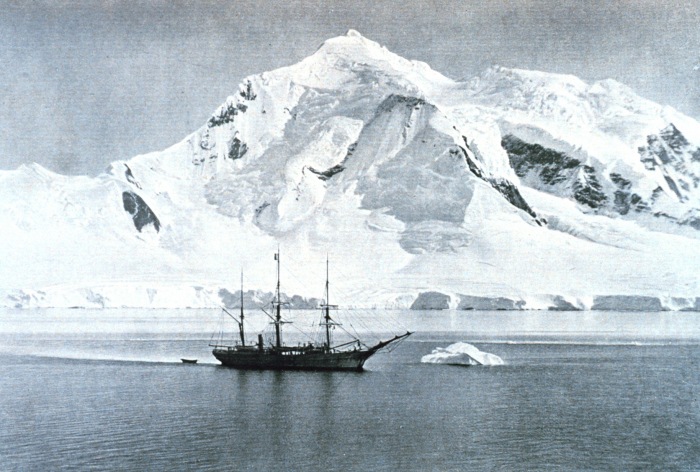
image by NOAA (source)
That expedition ran into trouble, though, as the ship became frozen in ice (intentionally at first? Wikipedia article's a little unclear there)
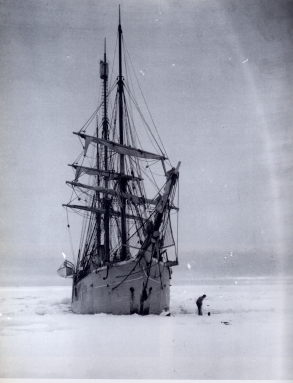
image by anonymous (source)
The Belgica was frozen there from February 28th, 1898 until March 18th, 1899, when they were finally able to get free from the ice thanks to clearing a path with "various tool" and dynamite. While stuck, food supplies became poor because the expedition leader didn't like the smell of the penguin and seal meat they had hunted up: subsisting on poor rations, a bunch of them got scurvy, and some went crazy; but once the expedition leader got sick, the expedition's doctor took over, broke out the meat, and the crew gradually recovered. Apparently they found no meteorites, however. =p)
|
·····
|
| |
| The classy old look | May 07, 2011 3:57 AM PDT | url |
| | |
Added 1 new A* page:I think as I was drawing Selenis' jacket in today's page, I was thinking of this recent strip of PvP; I don't follow that comic, but the author is doing a retro look right now, and he's really captured the elegant lines and heavy inks of the classic adventure strips (although from his blog it sounds like he may be borrowing pretty directly from old sources); the one I have on hand is some of Sydney Jordan's Jeff Hawke (I wrote a bit about that here, but there were plenty of others from that era with a fairly similar look).
I thought it was interesting that the PvP blog entry also mentions Chris Samnee as a contemporary dude who knows how to do that old look, as I follow Samnee's work on deviantART, and he really does do some great black and white work with modern brush pens. The rendering of the vest and pants here, for instance, is both impressive and reminiscent of the classic style--they really knew how to draw suits back then, that's for sure. And if you want to see how Samnee does it, this entry in his blog has a video of him at work; and you can tell he's a pro--he currently works for Marvel Comics--because he produces a nice, fully inked drawing in under half an hour, whereas something like that would probably take me half the day. :P
~~~~~~
Speaking of stuff that takes me half the day, my weekend fairy tale comic, "The Princess and the Giant," hit its 100th strip last Sunday! Yay. :) Here's a teaser / clickable link image to it:

And of course I'll be doing another one this Sunday--kind of let off the hook since my parents are busy and decided to postpone Mother's Day, which for the rest of you is also this Sunday!
|
·····
|
| |
| I draw slow! and other confessions | May 06, 2011 4:25 AM PDT | url |
| | |
Added 1 new A* page:I think (hope?) the art here has been getting a bit better lately, on average, and that would be mainly because I'm just spending more time on it; that wasn't consciously planned, but I suppose was just the consequence of my wanting to keep improving on it. The consequence, though, is that I get fewer pages done; if I keep on at this rate, for instance, days where I manage to get two pages done will be the exception, rather than the norm as they were in the previous few episodes.
It's the old quality vs quantity question, and I'm sort of teetering around here in the act of trying to find the right balance. I *prefer* to be able to take the time to do what feels like a decent job on the pages, as opposed to feeling like I'm having to rush to get them done all the time, but I worry that the pace of the story will feel too slow at a mostly one-a-day rate. So if you, dear reader, would like to take advantage of this confused and searching period of mine to influence the future course of the comic's development, now would be a super time to bowl me over with your take on the pace of the story, and/or the development (or otherwise!) of the art.
(The ideal solution, I suppose, would be for me to learn to draw faster, and I've been hoping that would happen for the past few years, but that particular breakthrough doesn't seem to be in any hurry to arrive, and I'm slowly reaching the conclusion that I draw kinda slow, at least when I'm trying to do a good job. It's so disillusioning! =P I suppose this strange lasso-drawing technique of mine isn't helping in the speed department, but I like it way too much to give it up now. Ironically, I first started using it as a way to speed up my sketching. Which worked, since you can lay down big shapes with it really quickly; it's when you need to go back in and refine them that things go much slower.)
~~~~~
Another thing I've been meaning to get off my chest! Another deep, dark A* secret! Well not really. You've probably even noticed that I take a few liberties with the pictorial representations of certain events--liberties which even I couldn't say fall strictly under the definition of "hard sci-fi." One of these happens fairly often, including in today's page. Can you spot it?
No, it isn't the stars and gas and dust clouds and stuff. I mean, I know I take liberties with those, but that isn't what I'm gonna talk about now! :D So look for something else.
Okay, here's a hint: it was maybe more obvious, or worse, anyway, in the last drawing of the shuttle, on page 19.
Well, here it is: in the second half of a speedy journey, properly speaking, a ship would turn around backwards, firing its main thrusters in the opposite direction in which it is traveling--that's how you brake. The problem is that I can't think of how to draw a ship turned around backwards in such a way that it will be immediately obvious to the viewer that the ship is *moving* backwards; I think the obvious assumption in almost all cases would be that the ship is moving the way in which it is pointing.
Now, if the ship was, say, leaving a trail of sparks or gas or something behind, you could do it, because the trail would show the ship's true direction of motion--I did that with Vero's damaged ship in episode 10, for instance, although it wasn't actually firing its thrusters there, since they were damaged.
So until I think of a way draw them facing backwards but appearing to fly forwards (and I don't want to cheat with Star Trek-style streaks of light sailing past...that would be tough to show direction with when it isn't animated, anyway), I'll just fudge things and have them facing forward, skipping over the main braking stuff (like how I just had Selenis refer to braking in passing back when she and Vero arrived at "the black system" in episode 9--bet you hadn't realized they were facing backwards on the previous page! :P); and if pressed on the matter, I can come up with snappy (if iffy) explanations! Check this out: on page 19, the ship appears to be firing its thrusters toward its destination, even though it should be braking, because um it's making a routine course correction. Or the gravity from the system's star dragged it a little more than had been planned. No that isn't sloppy at all! And here on page 23, the ship is facing forward, even though it should be coming to a stop, because uh it's already slowed to almost a stop, and can now simply use small maneuvering jets to stop itself as it goes in to dock or whatnot.
See? Totally hard sci-fi depiction going on there, yep.
|
·····
|
| |
| Field Experience | May 05, 2011 3:13 AM PDT | url |
| | |
Added 1 new A* page:An astronomy snippet I've been skipping over for a week or so, but hopefully it's still valid--since, according to the article on space.com, six planets will be aligned in the dawn sky for another week or so--and if you time it right, you can maybe get the Moon in there, too. Hm and the Earth would make the seventh planet, since you'll see that one at the same time if everything's close enough to the horizon as seen through your binoculars or telescope--neither of which I have. Plus I'm not much for getting up in the morning--darn these early rising planets!
~~~~~
This article on bigthink.com led me over to Wikipedia's asteroid mining page, which says that even a "relatively small" asteroid of 1 mile (1.6 km) in diameter could contain more than $20 trillion worth of metals--and that's in 1997 dollars, since that's when John Lewis published his book "Mining the Sky: Untold Riches from the Asteroids, Comets, and Planets" which apparently added things up.
That's...a lotta dough. And good confirmation for A*! I've always figured a large part of the economy in this society at the galactic core was based on mining, but I was always somewhat uneasy, thinking it might cost more to get to, extract, and move the stuff than the stuff would end up being worth...but with dollar amounts like $20 trillion for a smallish asteroid being flung about, I'm thinking it's probably going to be a pretty profitable industry after all. Yay for story validation! :D
And wait, that's not all! Because according to a bit at the bottom of that Wikipedia article, a 1980 NASA publication called Advanced Automation for Space Missions discussed the possibility of automated, self-replicating lunar mining stations. Well, I didn't think of the self-replicating part, but remember that just eight pages ago, Selenis revealed that the job she's applying for (undercover, of course) at Andiran Robotics has to do with "robotics in autonomous long-range mining operations." Sweet! So I thought of that only over thirty years after NASA thought of it in a much more profound way. ;)
Here's a funky concept image of asteroid mining that NASA made:
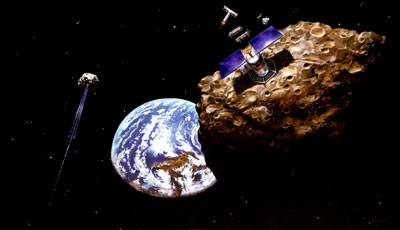
image by NASA (source)
It does make me wonder if self-replicating robots wouldn't get out of hand, though. I mean, there certainly haven't been any Hollywood movie plots along those lines or anything. >_> And if you can't trust writers for popular entertainment, who *CAN* you trust? So I think in A* they're wise to that, and don't do the self-replicating bit with their robots. :P
Oh! But that reminds me that self-replication--or large-scale maintenance and repair, anyway--forms the basis of something else very important to the plot in A*...which we'll get to eventually. Mm-hm! So it's good to know that smart people like NASA approve of such things, and I can safely hit it with my (very generous) "hard sci-fi" stamp of self-approval.
~~~~~~
The Wikipedia source page for that image above had a link to The Space Review, which appears to be a site where articles about space stuff are written--sort of like some of my news blog things here, only by people who actually know what they're talking about! For instance, their latest article is a history of the Redstone rocket, just in time for (according to the article) this week's 50th anniversary of the first American in space: a Redstone rocket pushed the Mercury capsule "Freedom 7" into Earth orbit with Alan Shepard aboard, a month after Yuri Gagarin's landmark flight for the Soviet Union.
And that isn't the last time the Americans and their rockets rushed for parity after the Soviets did something cool in space. For instance, (I got this from Wikipedia, not The Space Review), the US tried to launch their own satellite, the Navy's Vanguard TV3, on December 6, 1957--rushing to get it going several months after the USSR had shocked the Americans--who, typically, thought they were number 1--by launching Sputnik 1, the first man-made satellite. Well, the Vanguard rocket carrying the American answer to Sputnik got off the ground--four feet off the ground--before falling back and exploding rather spectacularly on the launch pad:
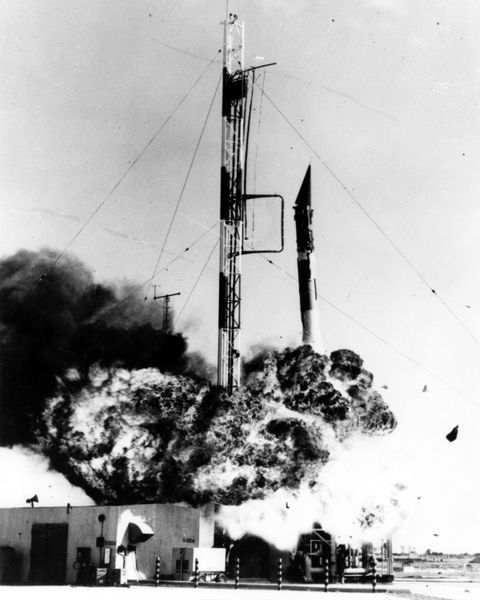
image by US Navy (source)
The poor thing was called nasty names in the US press: "kaputnik," "flopnik," "puffnik," and "stayputnik." Ouch!
So, on to round 2. The Space Review article mentions that just five days after the Soviets launched Sputnik 2--the first spacecraft to carry a living animal--the doomed dog Laika--on October 4, 1957, Wernher von Braun and his Army spaceflight team were given approval to attempt another satellite launch, and they succeed on January 31st, 1958, with the Explorer 1, kind of bailing out the Navy I suppose.
The Navy eventually succeeded, though (this is me from Wikipedia again), launching the Vanguard 1 on March 17th of that same year. As satellites go, it was a pitifully dinky, ugly thing, just six inches (16 cm) in diameter (contemporary Soviet Premier Nikita Khrushchev called it "the grapefruit satellite" :P)
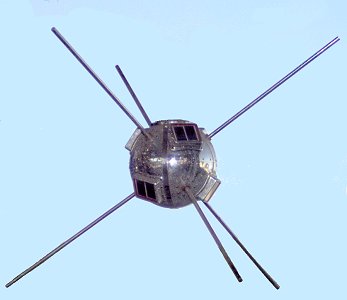
image by NASA (source)
but it kind of had the last laugh: it's still in orbit--the oldest satellite still up there, in fact! And its orbit it expected to last for another 200 years before it falls down into the atmosphere--originally it was thought that it might last 2000 years, but part of its scientific purpose was to test atmospheric drag at high orbits, and indeed it turned out that the atmosphere pulled on it more than expected; also, radiation pressure will apparently have played a role in shortening its life span. Still, it and two other Project Vanguard satellites are still orbiting, and have provided a great set of data for studying atmospheric drag. Vanguard 1 was also the first solar-powered satellite, maintaining a signal until 1964.
The other two Navy Vanguards (there were 11 Vanguard launch attempts, from 1957-59; only these three succeeded) that are still sailing around up there above our heads are 1959's Vanguard 2 and Vanguard 3; these two were bigger--20 inches (50 cm) in diameter, but they look a lot cooler; here are some mockups:
Vanguard 2 (mockup)
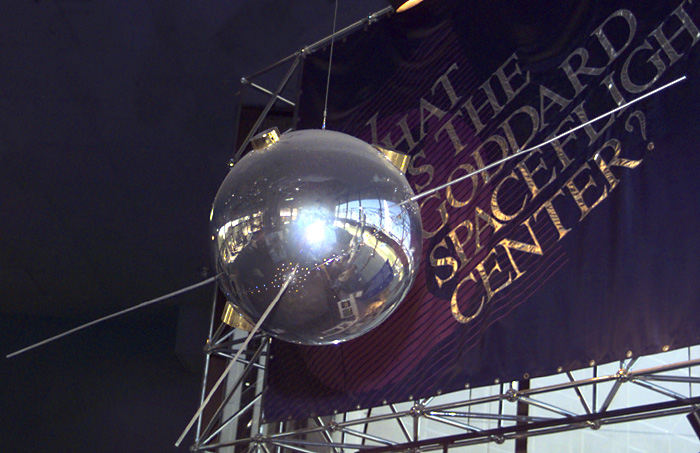
image by NASA (source)
Vanguard 3 (mockup)
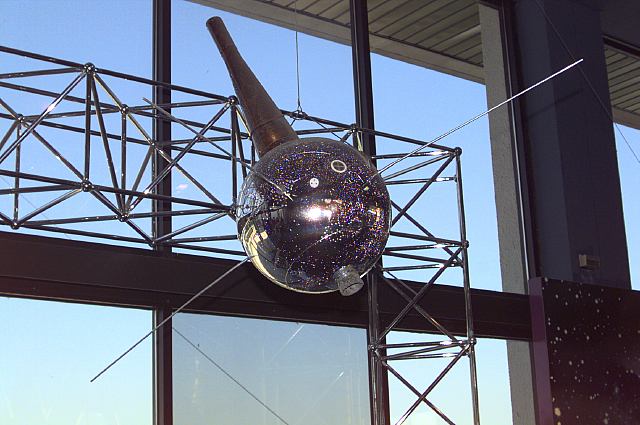
image by NASA (source)
So anyway, back to that Space Review article and the Redstone rocket line: the article says that the first test with the to-be-manned Mercury capsule design, MR-1, only got about 10 cm off the launch pad before the engines cut out; in this case, though, the rocket just settled back to the pad without exploding--BUT the launch escape system (remember how I mentioned last week that all manned US spacecraft have had launch escape systems, EXCEPT for the Space Shuttle?) on the Mercury capsule activated, shooting the escape rocket off--but leaving the capsule behind! Oops.
This sounded crazy so I had to go to Wikipedia and look up more info. Here's a photo to set the scene; the Redstone's engines have shut down and the rocket is settling back onto the pad, but you can see the escape rocket--that thingy way up at the tip of the nose--firing its thrusters to escape:
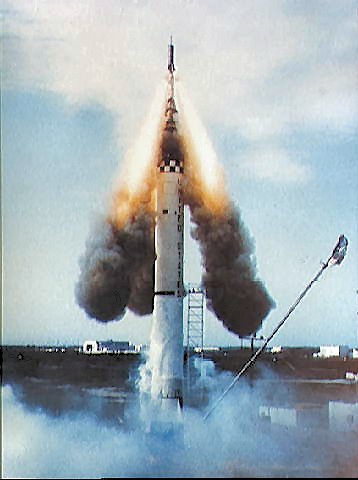
image by NASA (source)
What's supposed to happen is that the small emergency rocket at the top there fires, pulling the manned Mercury capsule and its occupant away from the main Redstone rocket, then deploying parachutes to settle the capsule safely back to Earth. That's what was *supposed* to happen; what actually happened on this first test flight was that when the escape rocket tried to carry off the Mercury capsule, sensors on the capsule detected 1 g of acceleration (normal Earth gravity!), and refused to detach, since it was only supposed to detach when the main rocket was nearly done firing and thus at lower-than-1-g acceleration. So the escape rocket just launched itself off the tip of the Redstone, landing 400 yards away. Meanwhile, the capsule, still sitting on top of the Redstone on the launch pad, deployed its drogue, main, and reserve parachutes.
So there was the Redstone: stuck on the pad, escape-rocket-free-Mercury capsule sitting on it, draped in three parachutes, with its retrorockets and self-destruct system still live--this was dangerous, particularly since high winds could have caused the parachutes to act as sails, dragging the rocket and all its fuel over. Fortunately, that didn't happen, and by the next day, the batteries on the Redstone and the Mercury capsule had depleted, and its liquid oxygen fuel had boiled off, so it could be taken down safely.
And then there was Mercury-Redstone 2 on January 31st, 1961, a 16.5-minute suborbital flight carrying Ham the Chimp; here he is in his "couch spacesuit," "shaking hands" with the commander of the recovery vessel after his flight:
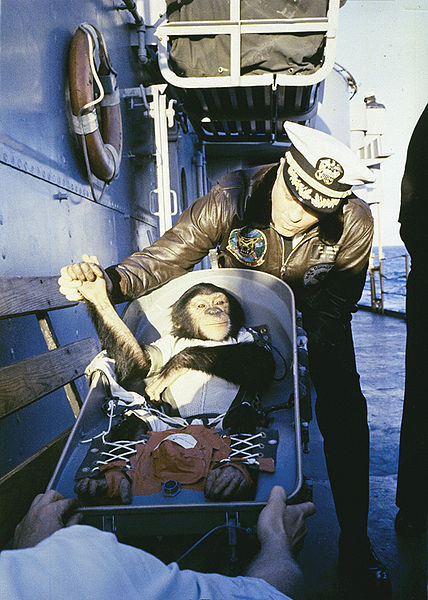
image by NASA (source)
Ham, or "Number 65" as he was known until he became a successful space hero, had been trained to throw a lever after seeing a flashing blue light: if he didn't throw the lever within five seconds of the light, he got an electric shock to the soles of his feet; but if he did it fast enough, he got a banana pellet, whatever that is. And for his 16.5 minutes of flight, including 6.6 minutes of weightlessness as the rocket arced high through the sky, he threw levers like a champ: 50 times, in all. I don't think they did anything.
But the flight outside of Ham's control actually had a lot of problems. It went up at too steep an angle--one degree too steep--which meant that it ran out of fuel too soon; this caused the escape rocket to fire, giving the Ham-carrying Mercury capsule even more acceleration; and the retrorockets were taken away with the abort, so they couldn't be used to slow the capsule down. "A speed of 5,857 mph (9,426 km/h) was reached instead of the 4,400 mph (7,081 km/h) planned," Ham was subjected to an extra 3 g of acceleration on reentry (14.7 g total) and the capsule overshot its mark by 48 miles. Not only that, but the capsule had lost most of its pressure during the flight--fortunately, Ham was safe in his couch spacesuit.
The capsule came down in the ocean off Florida about 60 miles from away from the rescue craft, and by the time the rescue choppers got to it, it was on its side, sinking: the beryllium heat shield had been pushed into the titanium capsule bulkhead, puncturing it in two places. But they fished it out in time to save Ham, who was rewarded with that handshake, plus an apple and half an orange for his adventure.
I wonder if he considered that a fair shake--he'd also gotten a bruised nose from the flight. At any rate, I was glad in reading his story that he actually survived; many animals in space programs were not so fortunate, although the first animals sent into space--American fruit flies in 1947--lived. Monkeys seemed to have worse luck; the first monkey in space, the American Albert II, seen launching in his V2 rocket here
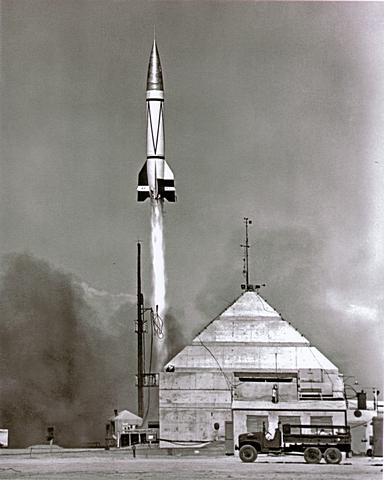
image by US Government (source)
died on impact in 1949, his parachute having failed to deploy (that's more than Space Shuttle astronauts have, I suppose)--at least he'd got up to 83 miles high; Albert I only got to half that altitude.
...and apparently didn't live either, because the Wikipedia article notes that space monkeys didn't actually survive their missions until ten years later: in 1959, Rhesus monkey Able and squirrel monkey Baker survived a 360 mile altitude (for comparison, the International Space Station orbits just below 200 miles--so the monkeys got way up there), 16 minute rocket flight that subjected them to nine minutes of weightlessness, acceleration forces of 38 g (yikes), and a top speed of about 10,000 miles per hours. But Able died four days later from a reaction to anesthesia during surgery to remove an infected electrode.
Tough life being a space pioneer. It was the Space Race and the Cold War though, and I guess in the balance of things it looked like having bragging rights over The Enemy was worth more than the lives of however many dozens or hundreds of monkeys, mice, dogs, frogs, tortoises, rats, cats, fish, worms, and spiders--not to mention some humans--were sacrificed.
(Oh, that animal list reminded me of another detail: upon Ham's death 17 years after his flight, in 1983 at age 26 (some US research chimps have lived like 50 years, so I don't know if Ham reached what you could call a ripe old age), his body was designated for research, and to get a nice clean skeleton, they sent it to the Smithsonian, where it was subjected to the museum's colony of carcass-eating Dermestid beetles. Ewwww.)
So, yeah, The Space Review! It seems like a good place to start reading about space stuff. :)
|
·····
|
| |
| "Hot Mess" guest art | May 04, 2011 2:49 AM PDT | url |
| | | |
Added 1 new A* page:A co-author of the webcomic Hot Mess approached me recently about doing a drawing based on their strip, and he was very nice about it so I drew them a picture, which they have just put up on their site here (and also currently on the site's front page). The comic is inspired by the high school experiences of the other co-author, TV and radio personality Diana Falzone. The high-school character in the comic is a young and highly stylized rendition that I didn't think I could imitate too well, so I opted for a more realistic portrayal based somewhat more directly on Ms. Falzone's real-life appearance. I haven't done much portraiture in a while so it was a fun challenge!
|
·····
|
| |
| That's Edutainment | May 03, 2011 12:44 AM PDT | url |
| | |
Added 1 new A* page:Ohh, such a Monday. Always tricky drawing a new character, but here she is! This goggled gal will be showing up a few times this episode for somewhat contentious conversations with our deadly anti-heroine--but she wouldn't hit a girl with goggles, would she?
~~~~~~
Have you ever googled goggles? Well...neither have I. But I did notice a sort of increase in Google traffic to A* this weekend, and doing a bit of investigatory googling, noticed that this site is now on the first page of hits when you google "supermassive black hole." Yay! Of course, that means I'm potentially standing in the way of people trying to learn about supermassive black holes, which isn't so great I suppose...but hey, I got the Wikipedia page for 'em linked from my "about" page, so there. :P It's edutainment! Wait...
~~~~~~
Instead of going to bed like an intelligent person one night this weekend, I stayed up scribbling this:

Yeah, I'm not...really sure. It's *almost* like an "ancient" (not to mention sorta violent) version of the Princess character from my weekly fairy tale comic, The Princess and the Giant, so maybe that's it. Anyway, there it is! And for future reference, it's in the episode 13 gallery, accessible from the "episodes" link in this site's top menu.
~~~~~~
Speaking of comics drawn in lieu of sleep, this afternoon I happened across a webcomic series called The Crepusculars, which is basically a bunch of 24 hour comics (that means a series of comics drawn in a single 24-hour period--there's some day each year where a lot of people do that) from years past by the author, skorpen, and they're wonderfully silly and inventive adventures. You might enjoy them! Also, I recommend looking up "crepuscular," which as it turns out is an actual word, and a pretty nifty one, too!
|
·····
|
|
|
